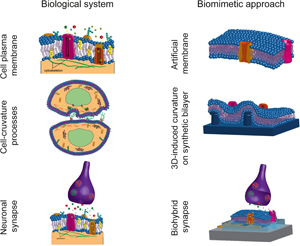Crossref Citations
This article has been cited by the following publications. This list is generated based on data provided by Crossref.
Forro, Csaba
Caron, Davide
Angotzi, Gian
Gallo, Vincenzo
Berdondini, Luca
Santoro, Francesca
Palazzolo, Gemma
and
Panuccio, Gabriella
2021.
Electrophysiology Read-Out Tools for Brain-on-Chip Biotechnology.
Micromachines,
Vol. 12,
Issue. 2,
p.
124.
Bruno, Ugo
Mariano, Anna
and
Santoro, Francesca
2021.
A systems theory approach to describe dynamic coupling at the cell–electrode interface.
APL Materials,
Vol. 9,
Issue. 1,
Galera-Laporta, Leticia
Comerci, Colin J.
Garcia-Ojalvo, Jordi
and
Süel, Gürol M.
2021.
IonoBiology: The functional dynamics of the intracellular metallome, with lessons from bacteria.
Cell Systems,
Vol. 12,
Issue. 6,
p.
497.
Koutsouras, Dimitrios A.
Amiri, Morteza Hassanpour
Blom, Paul W. M.
Torricelli, Fabrizio
Asadi, Kamal
and
Gkoupidenis, Paschalis
2021.
An Iontronic Multiplexer Based on Spatiotemporal Dynamics of Multiterminal Organic Electrochemical Transistors.
Advanced Functional Materials,
Vol. 31,
Issue. 22,
Mariano, Anna
Lubrano, Claudia
Bruno, Ugo
Ausilio, Chiara
Dinger, Nikita Bhupesh
and
Santoro, Francesca
2022.
Advances in Cell-Conductive Polymer Biointerfaces and Role of the Plasma Membrane.
Chemical Reviews,
Vol. 122,
Issue. 4,
p.
4552.
Jayaram, A.K.
Pappa, A.M.
Ghosh, S.
Manzer, Z.A.
Traberg, W.C.
Knowles, T.P.J.
Daniel, S.
and
Owens, R.M.
2022.
Biomembranes in bioelectronic sensing.
Trends in Biotechnology,
Vol. 40,
Issue. 1,
p.
107.
Han, Seok Hee
Oh, Min-Ah
and
Chung, Taek Dong
2022.
Iontronics: Aqueous ion-based engineering for bioinspired functionalities and applications.
Chemical Physics Reviews,
Vol. 3,
Issue. 3,
Bettucci, Ottavia
Matrone, Giovanni Maria
and
Santoro, Francesca
2022.
Conductive Polymer‐Based Bioelectronic Platforms toward Sustainable and Biointegrated Devices: A Journey from Skin to Brain across Human Body Interfaces.
Advanced Materials Technologies,
Vol. 7,
Issue. 2,
Valeriani, Davide
Santoro, Francesca
and
Ienca, Marcello
2022.
The present and future of neural interfaces.
Frontiers in Neurorobotics,
Vol. 16,
Issue. ,
Parmeggiani, Matteo
Ballesio, Alberto
Battistoni, Silvia
Carcione, Rocco
Cocuzza, Matteo
D’Angelo, Pasquale
Erokhin, Victor V.
Marasso, Simone Luigi
Rinaldi, Giorgia
Tarabella, Giuseppe
Vurro, Davide
and
Pirri, Candido Fabrizio
2023.
Organic Bioelectronics Development in Italy: A Review.
Micromachines,
Vol. 14,
Issue. 2,
p.
460.
Gerardo‐Nava, Jose L.
Jansen, Jitske
Günther, Daniel
Klasen, Laura
Thiebes, Anja Lena
Niessing, Bastian
Bergerbit, Cédric
Meyer, Anna A.
Linkhorst, John
Barth, Mareike
Akhyari, Payam
Stingl, Julia
Nagel, Saskia
Stiehl, Thomas
Lampert, Angelika
Leube, Rudolf
Wessling, Matthias
Santoro, Francesca
Ingebrandt, Sven
Jockenhoevel, Stefan
Herrmann, Andreas
Fischer, Horst
Wagner, Wolfgang
Schmitt, Robert H.
Kiessling, Fabian
Kramann, Rafael
and
De Laporte, Laura
2023.
Transformative Materials to Create 3D Functional Human Tissue Models In Vitro in a Reproducible Manner.
Advanced Healthcare Materials,
Vol. 12,
Issue. 20,
Forró, Csaba
Musall, Simon
Montes, Viviana Rincón
Linkhorst, John
Walter, Peter
Wessling, Matthias
Offenhäusser, Andreas
Ingebrandt, Sven
Weber, Yvonne
Lampert, Angelika
and
Santoro, Francesca
2023.
Toward the Next Generation of Neural Iontronic Interfaces.
Advanced Healthcare Materials,
Vol. 12,
Issue. 20,
Gkoupidenis, P.
Zhang, Y.
Kleemann, H.
Ling, H.
Santoro, F.
Fabiano, S.
Salleo, A.
and
van de Burgt, Y.
2023.
Organic mixed conductors for bioinspired electronics.
Nature Reviews Materials,
Vol. 9,
Issue. 2,
p.
134.
Belleri, Pietro
Pons i Tarrés, Judith
McCulloch, Iain
Blom, Paul W. M.
Kovács-Vajna, Zsolt M.
Gkoupidenis, Paschalis
and
Torricelli, Fabrizio
2024.
Unravelling the operation of organic artificial neurons for neuromorphic bioelectronics.
Nature Communications,
Vol. 15,
Issue. 1,
Bhagat, Pratistha
and
Upadhyay, Lata Sheo Bachan
2025.
A review towards sustainable analyte detection: Biomimetic inspiration in biosensor technology.
Journal of Biotechnology,
Vol. 398,
Issue. ,
p.
51.



